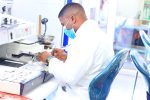Namibia is positioning itself to revolutionize Africa’s aquaculture sector with ambitious plans to establish two large-scale salmon farms along its cold, nutrient-rich coastline. If successful, the projects could propel the nation to the forefront of Atlantic salmon production on the continent, leveraging cutting-edge Norwegian technology and strategic environmental advantages.
The first venture, spearheaded by Austrian entrepreneur Johannes Aldrian’s Benguela Blue Aqua Farming (BBA), is set to unfold in Lüderitz. Announced in early 2024, BBA aims to develop a sprawling facility over the next decade, complete with hatcheries, processing units, and offshore rig-like structures. Aldrian projects annual production of 35,000 metric tons of salmon for both export and local markets. A second player, the Norway-backed African Aquaculture Company (AAC), has even grander ambitions: targeting 51,000 metric tons annually after securing permits in 2023. Together, these initiatives signal Namibia’s intent to carve out a niche in the global salmon market.
HARNESSING THE BENGUELA CURRENT
Central to Namibia’s strategy is the Benguela Current, a cold oceanic flow along its western coast. Experts compare these waters to Chile’s Humboldt Current, which underpins one of the world’s most productive aquaculture regions. Clement Kaukuetu, AAC’s Namibian partner and a veteran of the fishing industry, emphasizes that the current’s stable temperatures and rich nutrients create an ideal environment for Atlantic salmon—a species not native to African waters. Norwegian aquaculture specialists, integral to both projects, have endorsed the region’s potential, noting its alignment with sustainable farming practices.
AAC’s vision, developed in collaboration with Norwegian seafood veterans and former PwC partner Torben Foss, hinges on replicating Norway’s aquaculture success. The company has committed N$8.5 billion (approximately $450 million) to the effort, including pilot-phase investments of N$100 million. Freshwater hatcheries in Norway and South Africa will supply juvenile salmon, or smolt, which will be reared in offshore cages after reaching 150 grams. Harvesting will occur once the fish weigh 4.5 kilograms, with processing facilities onshore ensuring rapid distribution to global markets.
BALANCING GROWTH AND SUSTAINABILITY
While optimism abounds, challenges loom. Environmental groups, including the Worldwide Fund for Nature (WWF), warn that open-pen salmon farming risks biodiversity loss, chemical pollution, and disease spread between farmed and wild fish. Critics also highlight the industry’s reliance on wild-caught fish for feed—a practice linked to food insecurity in regions like northwest Africa. A 2024 report by NGO Feedback revealed that Norwegian salmon farms consume nearly 2 million metric tons of wild fish annually, much of it processed into fish oil sourced from areas grappling with malnutrition.
Proponents, however, argue that Namibia’s projects prioritize sustainability. Aldrian stresses that BBA will use antibiotic-free methods, vaccinated fish, and “escape-proof” offshore enclosures monitored by cameras to minimize feed waste. Similarly, AAC pledges to source feed from suppliers avoiding overfished stocks. Kaukuetu adds that Skretting, a global leader in sustainable fish feed, will supply AAC while disclosing ingredient origins publicly—a move aimed at transparency.
ECONOMIC AMBITIONS AND CONTINENTAL ASPIRATIONS
Beyond environmental considerations, the projects promise significant economic dividends. AAC anticipates creating 5,000 jobs across farming, logistics, and processing, while BBA aims for 600 direct and 1,500 indirect roles. Namibia’s proximity to European markets—a key destination for premium salmon—enhances its export appeal. Yet both companies also eye Africa’s burgeoning middle class. With the continent’s population nearing 1.4 billion, Kaukuetu and Aldrian envision addressing food security while tapping into rising demand for protein.
Aldrian, in particular, frames the initiative as pan-African. He envisions locally sourced feed ingredients to reduce costs and foster regional supply chains, noting that feed accounts for 60% of operational expenses. Meanwhile, AAC plans to expand into South Africa, exploring shore-based systems near Paarl to circumvent rougher southern seas.
A GLOBAL MARKET IN FLUX
The timing is strategic. Global salmon consumption has tripled since 1980, with aquaculture now supplying 70% of the market. Analysts project the industry’s value doubling to $36 billion by 2033. Yet competition is fierce: Norway alone exported 285,163 metric tons in early 2025, underscoring its dominance. Namibia’s output will initially pale in comparison, but its focus on sustainability and cost efficiency could differentiate it.
As the UN reports farmed fish volumes surpassing wild catch for the first time in 2024, Namibia’s bet on aquaculture reflects broader shifts in food production. Success, however, hinges on balancing ecological stewardship with economic ambition—a challenge the nation is now poised to tackle head-on. If realized, these salmon farms could redefine Africa’s role in global seafood markets while setting a precedent for sustainable growth. Additional reporting by Financialmail










